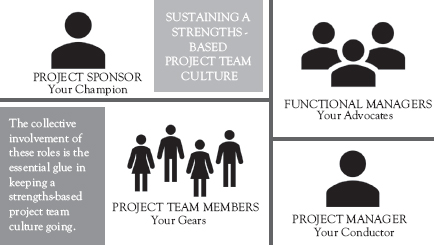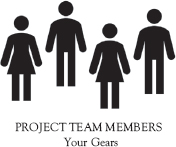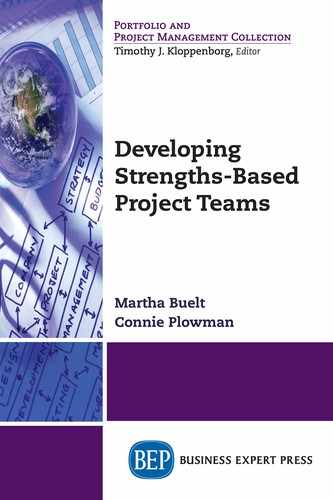Sustaining: Keeping a Strengths-Based Project Team Culture Going

The initial process of becoming a strengths-based project team is often new, exciting, and has momentum. Furthermore, the process takes time, energy, and resources. Working together as a team, you want your project team to continue to be a strengths-based project team over the life of the project—and beyond. This sustained effort enables you to truly maximize the investment you have made. How can you receive a long-term return on your initial strengths development investment and sustain your project team’s strengths-based momentum?
Further cultivating your project team’s strengths-based culture will yield a high return and continue to energize your team. In the process of developing your strengths-based project team, you have already started to develop a strengths-based culture. Your strengths-based culture flows from your project team members’ engagement and attitude toward the project team developing and using their strengths. A long-term strengths-based culture includes fertile ground for ongoing support, encouragement, and opportunities for project team members to develop and use their strengths every day.
The purpose of this chapter is to help you to see the importance of sustaining a strengths-based project team culture and how the following project management roles impact the culture:
1. The role of the project sponsor
2. The role of the functional managers
3. The role of the project manager
4. The role of all the project team members
Each of these project management roles is essential in creating and sustaining the strengths-based project team culture. Although the ways in which each of the different project management roles can influence and effect a strengths-based culture are distinct, they also have some commonalities and are closely interrelated. The collective involvement of these roles in the project team’s strengths-based development is the essential glue in keeping a strengths-based project team culture going.
One added note: How your organization is structured (projectized, matrix, functional, multi-divisional, etc.) may have a direct impact and influence on how you could best introduce, develop, and sustain a strengths-based project team culture. As you begin working with this process, think about how the process will work best and be accepted/supported in your company culture and structure.
The Role of the Project Sponsor
 The project sponsor is the project team’s champion for sustaining their strengths-based project team culture. In Chapter 2, we defined a project sponsor as a person, a group of people, or an organization who has authorized the project team to do the project. By definition, the project sponsor has ultimate control over the project, in that it is the project sponsor who is providing the resources, funding, permission, and support to do the project. Project sponsors influence the successful sustainability of a long-term strengths-based project team culture for their project teams when the project sponsor leads by example, provides support, and celebrates strengths-based project team successes.
The project sponsor is the project team’s champion for sustaining their strengths-based project team culture. In Chapter 2, we defined a project sponsor as a person, a group of people, or an organization who has authorized the project team to do the project. By definition, the project sponsor has ultimate control over the project, in that it is the project sponsor who is providing the resources, funding, permission, and support to do the project. Project sponsors influence the successful sustainability of a long-term strengths-based project team culture for their project teams when the project sponsor leads by example, provides support, and celebrates strengths-based project team successes.
Strengths-based project sponsors lead by example when they positively engage in their own strengths-development and then leverage their strengths in their sponsor role. As project team members see their sponsor engaging in the sponsor’s own strengths development and application, team members begin to trust that a long-term strengths-based project team culture will be sustained. This can motivate team members to more fully engage in developing and applying their strengths.
The project sponsor has some influence in providing what the project team needs to be a successful project team. Therefore, the sponsor may have some influence in providing resources and funding for initial and long-term strengths-based project team development. The sponsor can positively influence the project team’s strengths development success when the sponsor keeps the communication channels open with the project team to learn what the team needs for their continued strengths-based development, growth, and application.
Finally, the sponsor influences the sustainability of the project team’s strengths-based culture when the sponsor takes the time to celebrate the project team’s strengths-based successes with the team. Just like in the other project roles, project sponsors should be looking for and acknowledging talents and strengths in motion from the project team members. When they see project team members using their talents and strengths and tell the team members what they see, their positive comments further cultivate the sustainability of the project team’s strengths-based culture.
The Role of the Functional Managers
 The functional managers of the project team members contribute to influencing and impacting a strengths-based project team culture. Project team members’ functional managers are their short and long-term strengths development advocates, during the project and after the project’s completion. When each project team member starts individual strengths development with their functional manager’s positive and knowledgeable support, each team member is likely to fully engage in and continue developing and applying their strengths, maximizing the organization’s project team strengths-development return on investment.
The functional managers of the project team members contribute to influencing and impacting a strengths-based project team culture. Project team members’ functional managers are their short and long-term strengths development advocates, during the project and after the project’s completion. When each project team member starts individual strengths development with their functional manager’s positive and knowledgeable support, each team member is likely to fully engage in and continue developing and applying their strengths, maximizing the organization’s project team strengths-development return on investment.
Functional managers are in a position to provide their direct reports consistent, long-term mentoring and development. The functional manager has the ongoing responsibility and capability to influence their direct report’s receptiveness toward and opportunities for developing their strengths—as an individual contributor and a project team member. If project team members’ functional managers believe and engage in strengths development, then project team members have greater trust that the organization’s support of developing and using their strengths will be sustained. Trust in strengths sustainability will motivate project team members to more deeply engage in their project team’s strengths development process.
Once project team members begin the process of developing and using their strengths, they will want to continue the process even after the project is completed. Most often, project sponsors and project managers directly work with their project team members only for the length of the project. When the project ends, each team member may go to another project team—with a different project manager and perhaps a different project sponsor—or maybe back to their regular job working full-time for their functional manager. Therefore, the functional manager’s support is critical for each project team member’s long-term strengths engagement and career development. The functional manager can continue to provide their direct reports with what they need to continue developing and using their strengths—doing what they do best at work every day.
Even when a strengths-based project team disbands, project team members have the potential to bring their previous project team’s strengths-based culture into other project teams. Functional managers’ initial and long-term support will also increase the likelihood that project team members will use their strengths on future project teams, possibly influencing and leading to a strengths-based project team organizational norm.
Who has the responsibility to inform each project team member’s functional manager about the team becoming a strengths-based project team? Each project team member!
There is a twofold advantage for each of the project team members to be the person who informs their own functional manager about the team’s strengths-based development. First, since each team member usually has a functional manager, there can be as many functional managers as there are team members. Take a project team of five people: the team can have as many as five functional managers. Therefore, it could be a time-consuming task for the project manager to communicate in depth with each functional manager about the project team’s strengths-based development engagement and the talents and strengths of the functional manager’s respective direct report.
The second advantage, and more importantly, is that the project team member is taking an active role in being responsible for their own individual strengths development. The one-to-one communication between the functional manager and the project team member will allow time for the team member to articulate their talents and strengths and explain the strengths development process that the project team is engaging in. The functional manager will then have opportunity to ask questions and engage in strengths conversations with their direct report.
Although project team members have the ultimate responsibility to inform their functional manager about strengths development on the project team, project sponsors and project managers need to support and equip team members to inform and engage in strengths conversations with their functional managers. Equipping project team members to have strengths conversations can include giving them a list of ideas for starting the conversations, such as:
• Sharing their themes, talents, and strengths
• Explaining how they are developing their strengths
• Showing how they want to continue developing and using their strengths
• Sharing how they want to leverage their strengths in situations which seem to require their lesser talents
• Exploring strengths resources that would help the functional manager understand strengths development and application
The Role of the Project Manager
 The project manager is the conductor of the strengths-based project team: the project manager is leading and directing the team’s strengths development and application opportunities. A project manager can successfully contribute to sustaining the project team’s strengths-based culture by developing and using their own strengths as they lead, manage, support, and encourage their project team members to do the same. As a project manager engages in the process of investing in developing and using their strengths, they become a better project manager—and the project team notices!
The project manager is the conductor of the strengths-based project team: the project manager is leading and directing the team’s strengths development and application opportunities. A project manager can successfully contribute to sustaining the project team’s strengths-based culture by developing and using their own strengths as they lead, manage, support, and encourage their project team members to do the same. As a project manager engages in the process of investing in developing and using their strengths, they become a better project manager—and the project team notices!
When project managers develop and use their own strengths, they are “modeling” what it means to be a strengths-based project team member. For example, when the project manager includes her top five dominant themes in her email signature block and posts her top five themes on her desk, she is modeling strengths-based practices for her project team members.
Strengths-based project managers also help sustain the strengths-based culture by positively leading, encouraging, and equipping their team members to engage in and be responsible for their own long-term strengths development. For the duration of the project, project managers need to provide opportunities for the team to continue to learn about strengths philosophy and apply what they learn on the project team.
A sustained strengths-based culture includes the project manager encouraging team members to use their strengths toward the project. Strengths-based project managers value each team member and what each team member brings to the project team. They encourage team members to use their strengths to best contribute to the project team. They create an atmosphere for project team members to share with the team their talents and strengths so that they can articulate how they can best contribute to the team and ways to use their strengths in their roles rather than using their lesser talents.
Therefore, the project manager is setting the stage for their team members to also encourage each other. Team members need to take notice when their colleagues use their strengths and then share what they see with their fellow team members. Strengths-based project managers lead their project team to understand that their talent and strength differences are an advantage for the team and that they need each other to get the project accomplished. They encourage their team to form strengths-based complementary partnerships as they approach tasks and challenges.
A strengths-based project team culture depends on strengths conversations. Therefore, project managers need to weave strengths conversations into their project team meetings and when they meet one-to-one with their team members. They also need to encourage their team members to have strengths conversations outside of team meetings. Project managers model effective strengths conversations by asking good questions and listening carefully as their team members share their talents and strengths with them and the project team.
Once again, sustaining a strengths-based project team culture requires the involvement of all of the project team members’ functional managers. Strengths-based project managers encourage and equip their project team members to reach out to their functional manager about their individual and project team strengths-based development. Project managers can supply their team members with strengths-based resources and conversational prompts to help them share their themes, talents, and strengths with their functional manager. This is one way to equip team members to take charge of their own individual strengths development for sustaining the long-term use and development of their strengths. (See Appendix D for more conversational prompt ideas.)
As the project manager uses their own strengths and encourages others to do the same, the project team members begin to trust that the team will function long-term as a strengths-based project team, creating a culture where team members can use their strengths on the team. The project manager is continually seeking and identifying opportunities for utilizing a team member’s individual strengths on the project. This creates synergies for a greater project impact. It is essential that the project manager gives genuine praise and credit by linking an individual’s strengths to the project impact.
The Role of All Project Team Members
 Project team members are the gears that keep the strengths-based project team culture going for their team. Each team member needs to engage in the full strengths development model of discovering, appreciating, articulating, and applying their talents and strengths—applying this model again and again.
Project team members are the gears that keep the strengths-based project team culture going for their team. Each team member needs to engage in the full strengths development model of discovering, appreciating, articulating, and applying their talents and strengths—applying this model again and again.
It is “nice” to know about our talents and see how we are using them in our lives now; however, sustaining a strengths-based project team culture requires team members to continually, intentionally apply their strengths: First, investing in talents toward strengths and further developing strengths; then, intentionally leveraging existing strengths toward deliverables, tasks, and team challenges. As project team members continue to practice developing and applying their own strengths, they also need to encourage each other in the process.
As assignments or responsibilities are accepted by team members for deliverables and tasks, a strengths-based culture is further developed when project team members intentionally factor-in team members’ specific strengths in the assignment process by asking themselves:
• How can we maximize our collective strengths toward this deliverable? Toward this task?
• What team member(s) have the strengths to best carryout this task?
And once tasks are assigned, strengths-based project team members need to reflect on how they can best use their strengths to accomplish their respective tasks.
The process of how the team can best apply their strengths is also important for project team challenges. What are the team’s challenges? How can the project team’s collective strengths be used to best approach a specific challenge? Periodically revisiting the team’s challenges will help maximize the application of the team’s collective strengths, further strengthening the team’s strengths-based culture.
Project team members also effect a strengths-based culture when they take ownership of their own ongoing strengths development. Once again, each project team member needs to take the responsibility for informing their functional manager about their strengths development—what the team member is doing about and with strengths development—and seeking their functional manager’s support for keeping it going. In addition, each project team member needs to engage in ongoing one-to-one strengths conversations with their functional manager, project manager, and strengths partner (Chapters 4 and 6) for uncovering untapped talent and further developing their strengths.
Awareness of a team member’s individual strengths and their impact on project work is fundamental. However, awareness of the individual strengths of the other team members is equally important. Identifying ways to combine and collaborate the team’s collective strengths to create project impact will help sustain a strengths-based culture.
Finally, it is critical that each team member is contributing their insights, ideas, and strengths while working together as a strengths-based project team to sustain a strengths-based culture.
Summary
In order to sustain a strengths-based project team culture, and further develop that culture, the project sponsor, functional managers, the project manager, and all project team members need to be on board. It is the collective involvement of these roles that provides the essential glue in keeping a strengths-based project team culture going.
Project sponsors can influence the successful sustainability of a long-term strengths-based project team culture when they lead by example, provide support, and celebrate strengths-based project team success. The functional manager of each project team member can influence and impact the sustainability of a strengths-based culture by providing their direct reports with consistent, long-term mentoring and development. The project manager needs to seek opportunities for the team to continue to learn about strengths philosophy and apply what they learn on the project team. And all of the project team members need to take ownership to engage and apply their own ongoing strengths development.
The whole project team is in this together—everyone is the glue to sustaining a strengths-based project team culture.
Key Questions
1. When you think of “owning” your own strengths development, what does that mean to you? What steps would you put in place to demonstrate your ownership to your functional manager, project manager, project sponsor, or team colleagues?
2. Think about the strengths-based project team culture in your current project, department, or organization. What does it look like today? What could it look like in the future? How can you contribute to establishing, growing, and sustaining a strengths-based project team culture?
3. Imagine a one-to-one conversation with your functional manager about your interest in strengths development. What would be the top three things that you would share with your functional manager? What support would you need from your functional manager to continue your strengths development?
